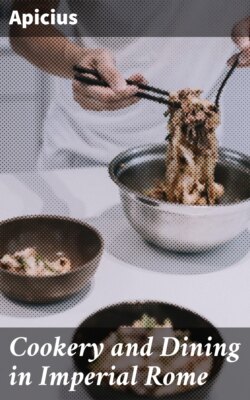Читать книгу Cookery and Dining in Imperial Rome - Apicius - Страница 34
На сайте Литреса книга снята с продажи.
Meat Diet
ОглавлениеTable of Contents
In perusing Apicius only one or two instances of cruelty to animals have come to our attention (cf. recipes No. 140 and 259). Cruel methods of slaughter were common. Some of the dumb beasts that were to feed man and even had to contribute to his pleasures and enjoyment of life by giving up their own lives often were tortured in cruel, unspeakable ways. The belief existed that such methods might increase the quality, palatability and flavor of the meat. Such beliefs and methods may still be encountered on the highways and byways in Europe and Asia today. Since the topic, strictly speaking does not belong here, we cannot depict it in detail, and in passing make mention of it to refer students interested in the psychology of the ancients to such details as are found in the writings of Plutarch and other ancient writers during the early Christian era. It must be remembered, however, that such writers (including the irreproachable Plutarch) were advocates of vegetarianism. Some passages are inspired by true humane feeling, but much appears to be written in the interest of vegetarianism.
The ancients were not such confirmed meat eaters as the modern Western nations, merely because the meat supply was not so ample. Beef was scarce because of the shortage of large pastures. The cow was sacred, the ox furnished motive power, and, after its usefulness was gone, the muscular old brute had little attraction for the gourmet. Today lives a race of beef eaters. Our beef diet, no doubt is bound to change somewhat. Already the world’s grazing grounds are steadily diminishing. The North American prairies are being parcelled off into small farms the working conditions of which make beef raising expensive. The South American pampas and a strip of coastal land in Australia now furnish the bulk of the world’s beef supply. Perhaps Northern Asia still holds in store a large future supply of meat but this no doubt will be claimed by Asia. Already North America is acclimating the Lapland reindeer to offset the waning beef, to utilize its Northern wastes.
With the increasing shortage of beef, with the increasing facilities for raising chicken and pork, a reversion to Apician methods of cookery and diet is not only probably but actually seems inevitable. The ancient bill of fare and the ancient methods of cookery were entirely guided by the supply of raw materials—precisely like ours. They had no great food stores nor very efficient marketing and transportation systems, food cold storage. They knew, however, to take care of what there was. They were good managers.
Such atrocities as the willful destruction of huge quantities of food of every description on the one side and starving multitudes on the other as seen today never occurred in antiquity.
Many of the Apician dishes will not appeal to the beef eaters. It is worthy of note that much criticism was heaped upon Apicius some 200 years ago in England when beef eating became fashionable in that country. The art of Apicius requires practitioners of superior intellect. Indeed, it requires a superior clientèle to appreciate Apician dishes. But practitioners that would pass the requirements of the Apician school are scarce in the kitchens of the beef eaters. We cannot blame meat eaters for rejecting the average chef d’œuvre set before them by a mediocre cook who has learned little besides the roasting or broiling of meats. Once the average man has acquired a taste for the refined compositions made by a talented and experienced cook, say, a composition of meats, vegetables or cereals, properly “balanced” by that intuition that never fails the real artist, the fortunate diner will eventually curtail the preponderant meat diet. A glance at some Chinese and Japanese methods of cookery may perhaps convince us of the probability of these remarks.
Nothing is more perplexing and more alarming than a new dish, but we can see in a reversion to Apician cookery methods only a dietetic benefit accruing to this so-called white race of beef eaters.
Apicius certainly excels in the preparation of vegetable dishes (cf. his cabbage and asparagus) and in the utilization of parts of food materials that are today considered inferior, hardly worth preparing for the table except by the very careful and economical housekeeper. Properly prepared, many of these things are good, often more nutritious than the dearer cuts, and sometimes they are really delicious.
One has but to study the methods of ancient and intelligent people who have suffered for thousands of years under the perennial shortage of food supplies in order to understand and to appreciate Apician methods. Be it far from us to advocate their methods, or to wish upon us the conditions that engendered such methods; for such practices have been pounded into these people by dire necessity. They have graduated from the merciless school of hunger.
Food materials, we repeat, were never as cheap and as abundant as they are today. But who can say that they always will be so in the future?
